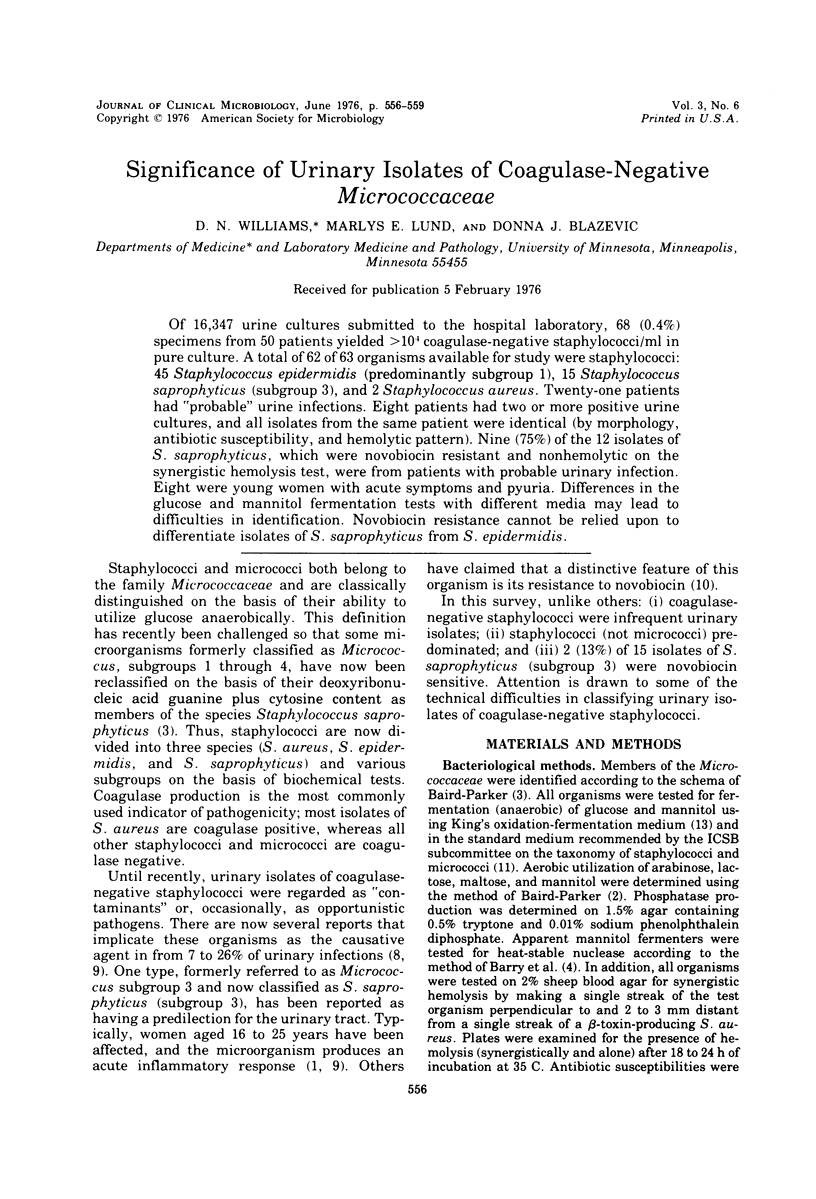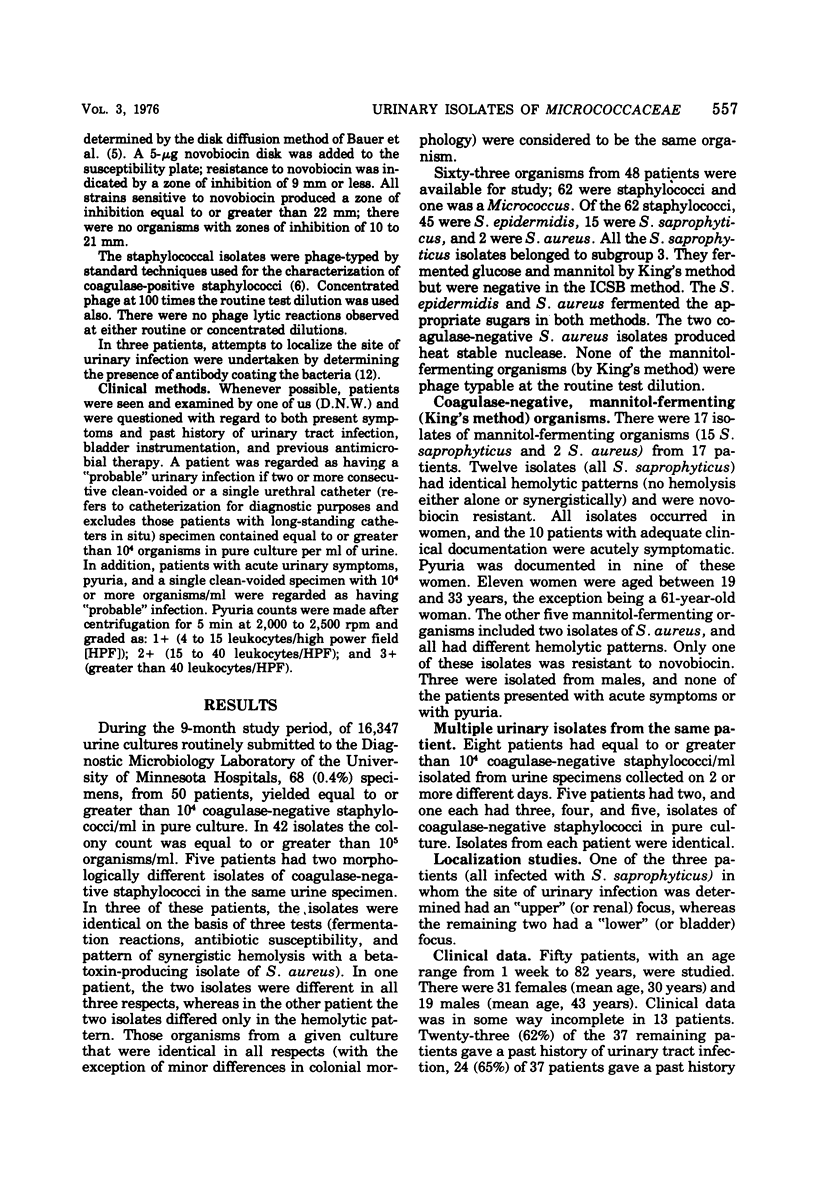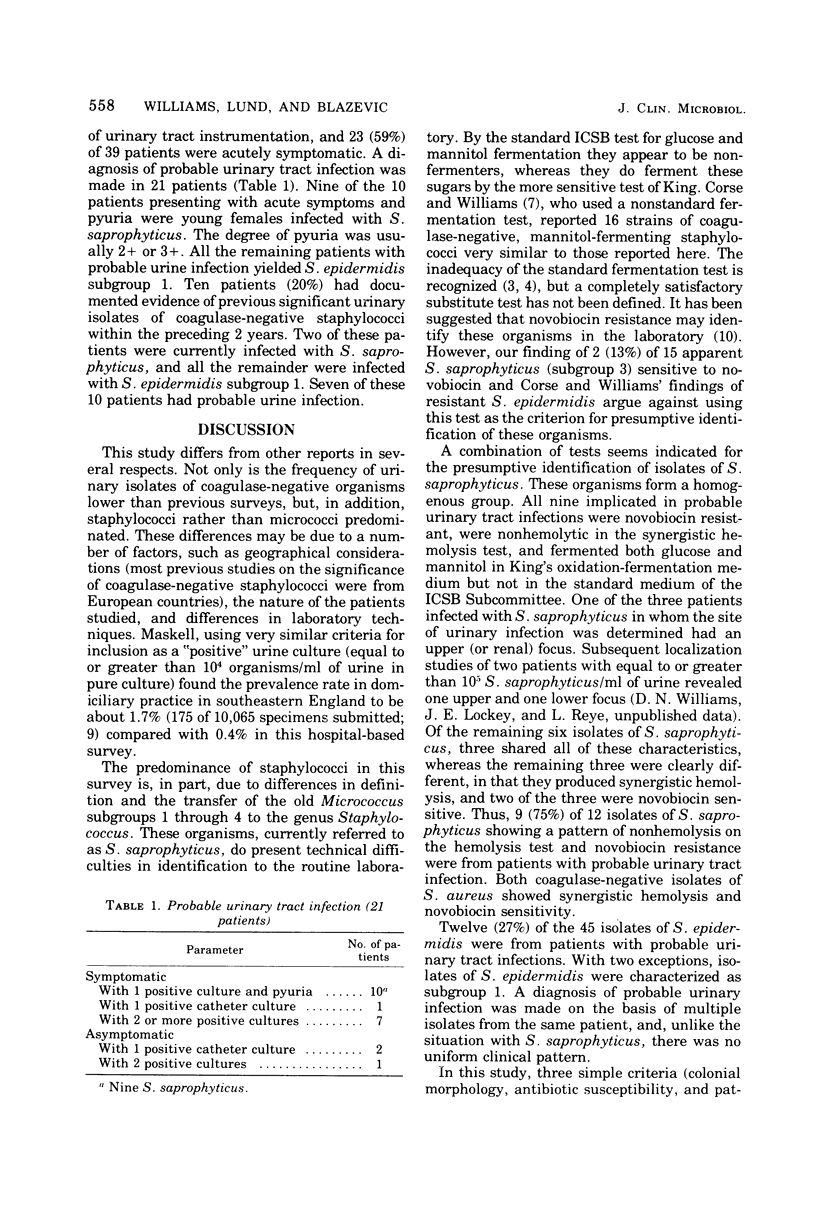Abstract
Of 16,347 urine cultures submitted to the hospital laboratory, 68 (0.4%) specimens from 50 patients yielded greater than 10(4) coagulase-negative staphylococci/ml in pure culture. A total of 62 of 63 organisms available for study were staphylococci: 45 Staphylococcus epidermidis (predominantly subgroup 1), 15 Staphylococcus saprophyticus (subgroup 3), and 2 Staphylococcus aureus. Twenty-one patients had "probable" urine infections. Eight patients had two or more positive urine cultures, and all isolates from the same patients were identical (by morphology, antibiotic susceptibility, and hemolytic pattern). Nine (75%) of the 12 isolates of S. saprophyticus, which were novobiocin resistant and nonhemolytic on the synergistic hemolysis test, were from patients with probable urinary infection. Eight were young women with acute symptoms and pyuria. Differences in the glucose and mannitol fermentation tests with different media may lead to difficulties in identification. Novobiocin resistance cannot be relied upon to differentiate isolates of S. saprophyticus from S. epidermidis.
Full text
PDF



Selected References
These references are in PubMed. This may not be the complete list of references from this article.
- BAIRD-PARKER A. C. A classification of micrococci and staphylococci based on physiological and biochemical tests. J Gen Microbiol. 1963 Mar;30:409–427. doi: 10.1099/00221287-30-3-409. [DOI] [PubMed] [Google Scholar]
- Bailey R. R. Significance of coagulase-negative Staphylococcus in urine. J Infect Dis. 1973 Feb;127(2):179–182. doi: 10.1093/infdis/127.2.179. [DOI] [PubMed] [Google Scholar]
- Baird-Parker A. C. The basis for the present classification of staphylococci and micrococci. Ann N Y Acad Sci. 1974 Jul 31;236(0):7–14. doi: 10.1111/j.1749-6632.1974.tb41478.x. [DOI] [PubMed] [Google Scholar]
- Barry A. L., Lachica R. V., Atchison F. W. Identification of Staphylococcus aureus by simultaneous use of tube coagulase and thermonuclease tests. Appl Microbiol. 1973 Mar;25(3):496–497. doi: 10.1128/am.25.3.496-497.1973. [DOI] [PMC free article] [PubMed] [Google Scholar]
- Bauer A. W., Kirby W. M., Sherris J. C., Turck M. Antibiotic susceptibility testing by a standardized single disk method. Am J Clin Pathol. 1966 Apr;45(4):493–496. [PubMed] [Google Scholar]
- Corse J., Williams R. E. Antibiotic resistance of coagulase-negative staphylococci and micrococci. J Clin Pathol. 1968 Nov;21(6):722–728. doi: 10.1136/jcp.21.6.722. [DOI] [PMC free article] [PubMed] [Google Scholar]
- Mabeck C. E. Significance of coagulase-negative staphylococcal bacteriuria. Lancet. 1969 Nov 29;2(7631):1150–1152. doi: 10.1016/s0140-6736(69)92481-7. [DOI] [PubMed] [Google Scholar]
- Maskell R. Importance of coagulase-negative staphylococci as pathogens in the urinary tract. Lancet. 1974 Jun 8;1(7867):1155–1158. doi: 10.1016/s0140-6736(74)90634-5. [DOI] [PubMed] [Google Scholar]
- Mitchell R. G., Baird-Parker A. C. Novobiocin resistance and the classification of staphylococci and micrococci. J Appl Bacteriol. 1967 Apr;30(1):251–254. doi: 10.1111/j.1365-2672.1967.tb00296.x. [DOI] [PubMed] [Google Scholar]
- Thomas V., Shelokov A., Forland M. Antibody-coated bacteria in the urine and the site of urinary-tract infection. N Engl J Med. 1974 Mar 14;290(11):588–590. doi: 10.1056/NEJM197403142901102. [DOI] [PubMed] [Google Scholar]
- Williams D. N., Crossley K., Hoffman C., Sabath L. D. Parenteral clindamycin phosphate: pharmacology with normal and abnormal liver function and effect on nasal staphylococci. Antimicrob Agents Chemother. 1975 Feb;7(2):153–158. doi: 10.1128/aac.7.2.153. [DOI] [PMC free article] [PubMed] [Google Scholar]


